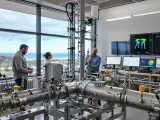
Green Hydrogen Framework Takes Shape in Jordan’s 2025 Gas Bill
August 11, 2025Why a Gas Bill Matters for Green Hydrogen
Ever wondered how a single piece of legislation can chart a nation’s renewable energy journey? Well, on August 10, 2025, Jordan’s Cabinet gave the thumbs up to the 2025 Gas Bill—a real game-changer that updates centuries-old gas rules and paves the way for green hydrogen and its offshoots. Think of it like swapping out an aging, pot-holed road for slick, smart highways designed just for zero-emission vehicles. Suddenly, investors, developers, and regulators all share a clear roadmap for getting natural gas, biomass-derived gases, and hydrogen from import terminals, through high-pressure pipelines, and right into our factories, homes, and transport networks—under open, no-surprises licensing and fee structures.
A Unified Framework for Gas and Hydrogen
At its core, this bill stretches Jordan’s existing natural gas laws to embrace hydrogen, biogas, and biomethane, too. It hands the reins to the Ministry of Energy and Mineral Resources (MEMR) to run competitive tenders—or, where appropriate, cut straight to the chase with direct offers—for shared transmission, distribution, or storage ventures. Overseeing the whole show is the Energy and Minerals Regulatory Commission (EMRC), now armed with full-throttle powers—from import permits to retail tariffs. It’s a neat public–private handoff: facilities can either serve their own needs or throw open their doors to outside players, all under a playbook that guarantees fair access, clear fees, and streamlined dispute resolution.
Building a Modern Energy Transmission System
Perhaps the flashiest bit? A standalone energy transmission system—imagine a parallel grid tailor-made for renewables and storage. Solar farms, wind parks, battery banks, and hydrogen electrolyzers will plug into this regulated network, which can even disconnect from the main grid to dodge spikes or blackouts. Upfront licensing rules and connection fees spell out exactly what developers can expect—no more guesswork. From a practical standpoint, this setup tackles the jittery nature of variable renewables and lays the groundwork for scalable hydrogen infrastructure, which is key if you’re thinking big on electrolysis plants or large-scale green hydrogen hubs.
Certification and Traceability for Green Hydrogen
To build trust, the law calls for an international-grade hydrogen certification and traceability system. Picture a digital passport for every kilo of hydrogen produced, tracking its renewable electricity source, carbon footprint, and whole chain of custody. Regular compliance checks and tamper-proof data logs—aligned with global protocols—will give everyone from heavy industry to fleet operators the confidence that they’re running on the real deal: zero-carbon fuel. In turn, this transparency could open export doors where buyers insist on verifiable green credentials, boosting Jordan’s standing in the global sustainable energy market.
Sectoral Reforms: Tourism and Transport
Jordan didn’t stop at energy. A fresh Tourism Sector Development and Support Fund is now in play, alongside tweaks to the bylaws of the Jordan Hotel and Restaurants Associations—aimed at smoothing governance, unifying fees, and funneling cash into eco-friendly tourism projects. Over in transport, ride-hailing and smart shuttle apps face new rules: a JD100,000 financial guarantee, unified e-payment systems, real-time GPS tracking, age limits for vehicles, and clear performance benchmarks. It’s a one-two punch designed to level up service quality, stoke healthy competition, and dovetail neatly with Jordan’s broader sustainable mobility ambitions—imagine hopping between a hydrogen shuttle and an e-hailing ride using just one app.
Harmonizing Administrative Boundaries
You might be wondering how energy policy ties into map-making. Under these new decisions, standardized administrative boundary maps will be shared across public entities—from security forces and municipalities to courts—so everyone’s working off the same geographic playbook. This isn’t just redrawing lines on paper; it’s about stopping unauthorized sprawl, fine-tuning land-use planning, and making sure emergency responders know exactly which roads and zones fall under their watch.
Investing in Health and Education Infrastructure
On the social side, the Cabinet gave the green light to Mutah University to transform a 7,500 m² state-owned building in Karak into a dental clinical teaching facility. Structured in three phases over 600 days, this JD7 million-plus project will be funded by the university’s own coffers, CSR contributions, and a BOT contract. Meanwhile, JD1.3 million was approved to hook up the new JD88 million Madaba Hospital—built with KBW Investments chaired by Prince Khaled bin Alwaleed—to the national power grid, ensuring uninterrupted power for critical services like surgical suites and emergency rooms.
Looking Ahead
When you stitch all these pieces together, you get a picture of policy-making that’s as holistic as it is ambitious. By weaving sustainable energy goals into a broader reform package—linking hydrogen policy with tourism, transport, education, and healthcare—Jordan is sketching out a complex but coherent roadmap for national development. Of course, the real test will be execution: can regulators keep pace, can the rules adapt to shifting international standards, and can private capital be rallied to the cause? But if Jordan nails it, it could become a blueprint for other energy-importing nations looking to pivot to a low-carbon future—one regulation at a time.



 With over 15 years of reporting hydrogen news, we are your premier source for the latest updates and insights in hydrogen and renewable energy.
With over 15 years of reporting hydrogen news, we are your premier source for the latest updates and insights in hydrogen and renewable energy.